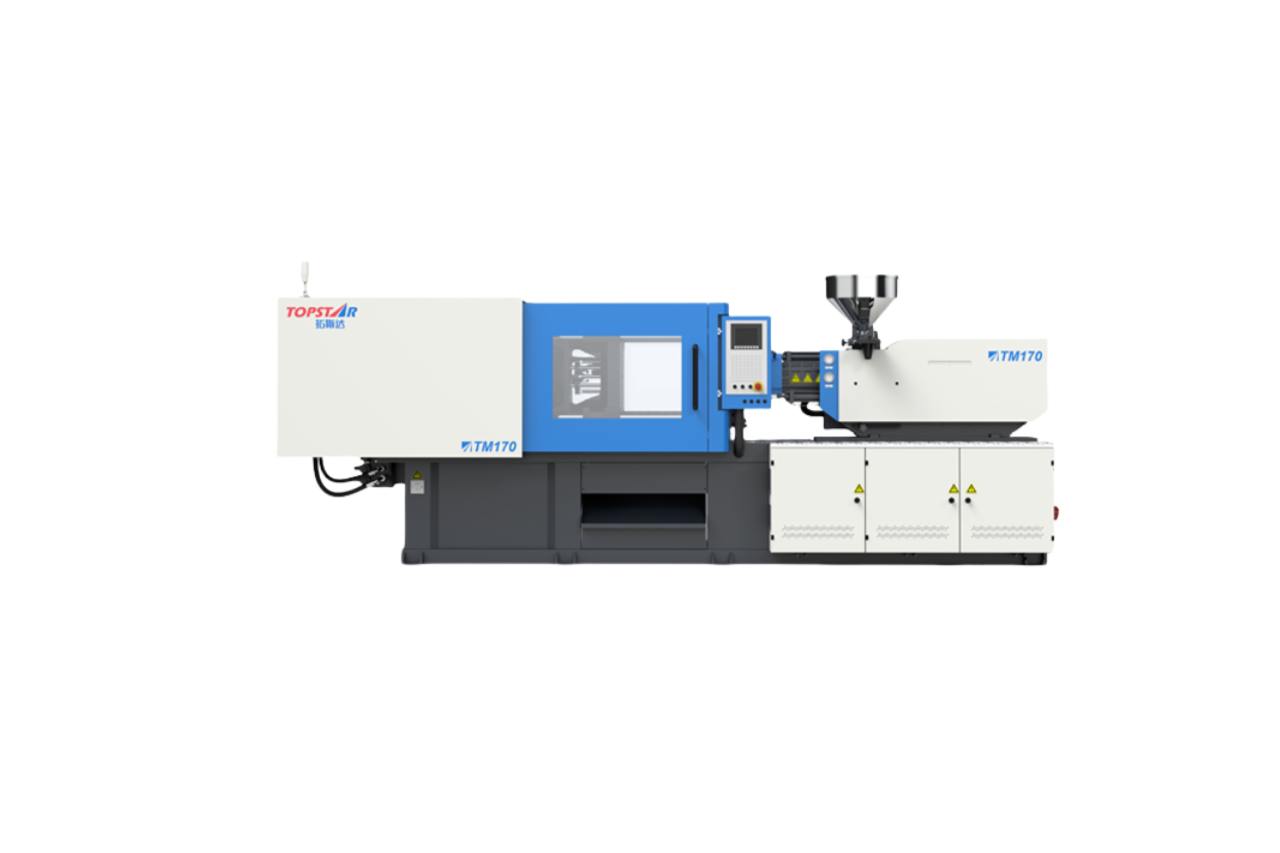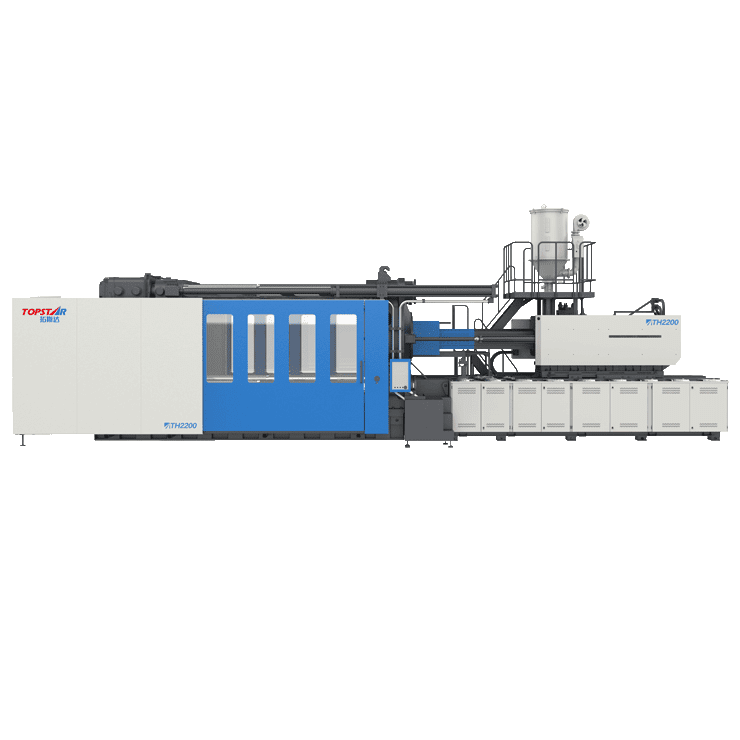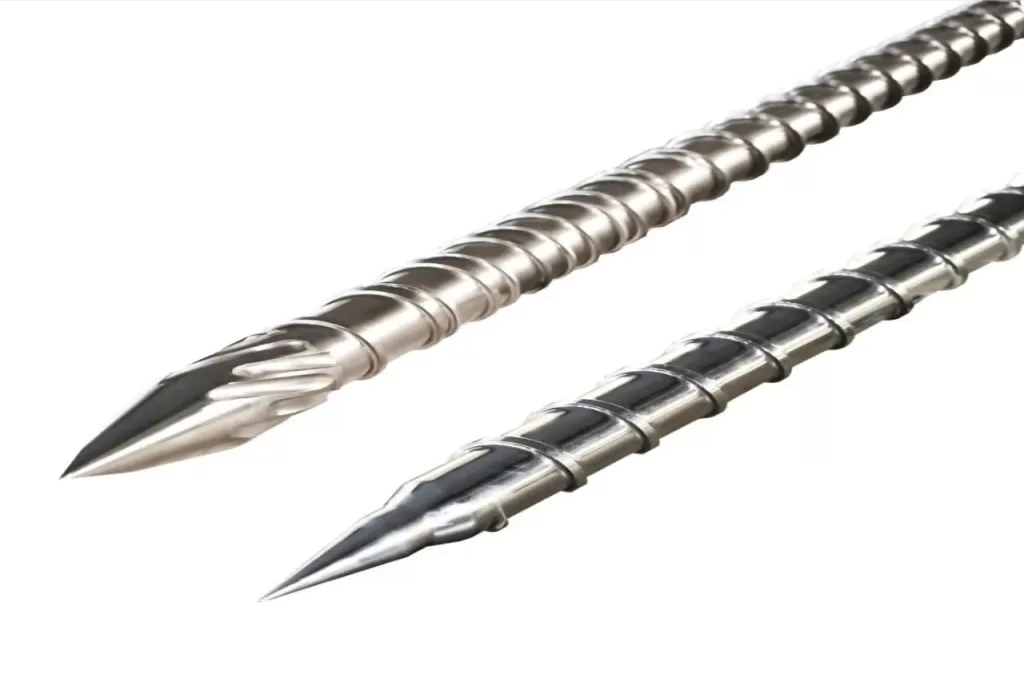How to avoid the deviation load of a large injection molding machine?
2025/06/13 By Topstar

Deviation loads are often encountered when operating large injection molding machines, where unexpected lateral forces cause the injection cylinder to deviate from its center. These loads can originate from uneven melt pressure in the injection molding machine, inconsistent clamping force, or slight wear of the guide components. When the molten plastic rushes into one side of the mold at slightly higher pressure, an unbalanced force is generated, trying to twist the injection unit. As a result, this lateral force or deviation load stresses the screw, causing uneven wear of the linear guides and reducing accuracy. In addition, the magnitude of these lateral forces gradually increases with increasing tonnage, so we avoid deviation loads to improve production consistency.
Key factors affecting deviation loads in large injection molding machine performance
Several factors influence deviation loads on large injection molding machines. First, melt viscosity is one reason. Suppose there are slight changes in the viscosity of the same batch of resin. In that case, it will also cause uneven flow into the mold cavity, thereby generating lateral forces on the injection cylinder. Second, fluctuations in barrel temperature or heating coil performance can exacerbate these viscosity differences, leading to higher deviation loads during startup or prolonged operation. In addition, mold design may also cause uneven flow channels.
In addition, mechanical wear from production with long cycle times can also exacerbate deviations. Guide bearing wear, seal degradation, and reduced cylinder parallelism can all lead to unbalanced loads. Therefore, engineers can review component wear through inspection, testing, and analysis. In addition, machine setup errors, such as slight misalignment of the injection unit with the clamping plate or incorrect sensor calibration, can also lead to repeatable deviation loads.

Using a two-way synchronous injection cylinder structure on large injection molding machines
To alleviate deviation loads, we utilize a two-way synchronous injection cylinder structure in large injection molding machines. Unlike traditional single-rod cylinders, the two-way design supports the front and back of the piston rod simultaneously, thereby balancing the forces during injection and preventing bending moments. As a result, the injection cylinder maintains parallelism throughout the entire stroke, even at peak injection pressures. Additionally, the two-way synchronous design incorporates precision guide sleeves and adjustable preload bearings at both ends to ensure minimal radial clearance. As a result, the injection cylinder reacts evenly to the melt pressure, and the deviation load is negligible. By adopting a two-way synchronous injection cylinder structure, manufacturers can extend equipment life, reduce scrap rates, and maintain consistent mold quality during production.
How to prevent deviation loads from damaging the screw and linear guides?
The advantage of the bidirectional synchronous injection cylinder structure is its active correction ability. Any inherent misalignment or uneven resistance will generate a lateral force, and the synchronous injection cylinder will immediately apply an opposing force to counteract it. If the screw tries to deviate to the left, the right cylinder will automatically apply a slightly larger force, effectively counteracting the lateral thrust. At the same time, they ensure that the resultant force vector remains perfectly aligned with the screw center axis throughout the injection stroke.

For linear guides, the lateral forces are neutralized, and the linear guides are no longer subject to substantial, uneven point loads. The carriage supporting the screw assembly moves smoothly and evenly along the guide rails, correctly distributing the load and minimizing friction and wear on these critical precision parts.
Reduce wear and extend the life of the injection molding machine.
The bidirectional synchronous injection cylinder structure eliminates deviation loads, extending the injection molding machine’s screw and barrel life. By avoiding continuous lateral grinding, it also significantly reduces wear on the screw and barrel. In addition, the smooth, aligned stroke produced prevents indentation and excessive wear on the linear guide and its bearings. This maintains the precision of the injection molding machines for a longer period, avoiding the need for expensive guide replacement or re-machining. The thrust bearing is responsible for bearing the massive axial injection force and for bearing uniform loads without the additional destructive bending moments caused by deviation loads.
The reduced wear of these key components directly translates into more consistent injection speed and pressure curves throughout the machine’s life, which in turn contributes to improved part quality consistency.
Get higher operational and quality results
The benefits of eliminating deviation loads on large injection molding machines go far beyond reducing maintenance costs and extending component life. It can improve part quality. The consistent linear injection force minimizes fluctuations in melt flow and pressure in the barrel. This enables the mold cavity to fill more evenly, thereby reducing defects such as insufficient material, flash in specific areas, or inconsistent dimensions.
It can also improve process stability. A large injection molding machine that is not affected by the instability of deviation loads can run more predictably and achieve and maintain reliability during each injection process, thereby simplifying process setup and optimization. In addition, eliminating the deviation load also reduces energy losses, lowering the operating energy consumption of large injection molding machines and extending their normal runtime.
Reduce deviation loads through a two-way synchronous injection cylinder structure
The two-way synchronous injection cylinder structure can directly solve the deviation load of the injection molding machine, thereby protecting the screw and linear guide from destructive lateral loads. By actively neutralizing the deviation load in each injection cycle, this technology provides better protection for the screw, barrel, and linear guide. The result is a significant extension of the life of large injection molding machines, reduced maintenance costs, and enhanced process stability.
TRENDING POSTS
- TOPSTAR Global Open Day 2025: Humanoid Robot Debuts, Pioneering a New Decade of Intelligent Manufacturing 2025/06/13
- Topstar Showcases TE II Electric Injection Molding Machines at InterPlas Thailand 2025 2025/06/13
- Topstar Expands Its Ecosystem Partnerships to Drive Smart Manufacturing Innovation 2025/06/13
- What factors can cause delays in the injection molding process of plastic molding machine? 2025/06/13
HOT TOPIC
- .ervo motor-driven linear robots
- •
- 1.0 guangdong topstar technology co. ltd
- 1.0 topstar china
- 1.0 topstar robot
- 11
- 160℃ mold temperature controller
- 170 ton injection molding machine
- 2
- 21
- 220-ton injection molding machine
- 23
- 3 axis robot
- 3 axis robots
- 3 in 1 Compact Dehumidifying Dryer
- 3-axis robot
- 3-axis robots
- 39
- 41
- 460T injection molding machine
- 5-axis CNC machine
- 62
- 90 ton injection molding machine
- accuracy
- Air Chillers
- all electric injection molding machine
- all electric injection molding machines
- all-electric injection molding machine
- All-electric injection molding machines
- and overall production quality. Therefore
- AP-RubberPlas
- automated injection molding machine
- Automation changed engineering
- automation of injection molding robots
- automotive parts injection molding
- auxiliary machine
- Bench Injection Molding Machine
- Cabinet dryer manufacturers
- Cabinet dryers
- chiller
- CNC Drilling Machine
- CNC Drilling Machines
- cnc engraving machine manufacturer
- cnc laser cutting machine manufacturer
- CNC machine
- CNC Machine Center
- CNC Machine for Sale
- CNC Machine Manufacturing
- CNC Machine Tool
- CNC machine tool product
- CNC Machining Center
- CNC wood carving machine
- Cooling system
- Cross-Walking Single Axis Servo Cylinder Robot
- Cross-Walking Single-Axis Servo Cylinder Robot
- Cross-Walking Three-Axis/Five-Axis Servo Driven Robot
- cross-walking three-axis/five-axis servo-driven robot
- Dehumidifier Dryer
- Dehumidifying Dryer
- delta parallel robot
- Desktop Injection Molding Machine
- Desktop injection molding machines
- Desktop Molding Machine
- desktop plastic injection machine
- Desktop Plastic Injection Molding Machine
- Digital Transformation
- direct clamp injection molding machine
- Direct clamp injection molding machines
- Dosing & mixing system
- Drilling Centers
- Drying and dehumidification system
- drying and dehumidifying equipment
- Drying and Dehumidifying System
- drying system
- effective and efficient. Cabinet dryers are also used in other industries where large quantities of material need to be dried
- efficient injection molding machine
- elbow hydraulic injection molding machines
- electric injection molding machine
- electric injection molding machines
- energy-efficient injection molding robot
- energy-efficient water chiller
- energy-efficient water chillers
- energy-saving injection molding machine
- etc. Among injection molding robots
- exhibition
- features of CNC machine
- Feeding And Conveying System
- Five Axis Machine Center
- Flexible Production Line
- Fully automatic injection molding machine
- Gathering Topstar
- giant injection molding machine
- GMU-600 5-Axis Machining Center
- Granulating & Recycling System
- Heavy duty injection molding machine
- High-precision electric molding machines
- high-precision plastic molding machines
- high-speed all electric injection molding machine
- high-speed electric injection molding machine
- High-Speed Packaging Injection Molding
- Honeycomb rotor dehumidifier
- horizontal injection molding machine
- Horizontal Injection Molding Machines
- Horizontal Injection Moulding Machine
- Horizontal Mixer manufacturer
- How The CNC Machine Works
- hybrid injection molding machine
- hydraulic injection molding machine
- Hydraulic Injection Molding Machines
- in this article
- Industrial AI
- Industrial Automation
- Industrial robot
- Industrial Robot Chinese brand
- industrial robot parts
- industrial robot supplier
- Industrial robots
- Industry Chain
- Injection Manipulator
- injection manipulator robot
- injection mold machines
- Injection molding
- Injection molding automation
- Injection Molding Automation Solution
- injection molding dryer
- Injection molding equipment
- injection molding hopper dryer
- Injection molding machine
- injection molding machine brand
- Injection Molding Machine Factory
- Injection Molding Machine Manufacture
- Injection molding machine manufacturer
- injection molding machine manufacturers
- Injection molding machine procurement
- injection molding machine robotic arm
- injection molding machine with a robot
- Injection molding machines
- injection molding material dehumidifying
- injection molding plant
- injection molding process
- Injection Molding Robot
- injection molding robot arm
- Injection molding robot automation
- Injection molding robotic arm
- injection molding robots
- Injection moulding machine
- injection moulding machines
- Injection Moulding Robots
- Injection Robot
- Injection robot arm
- Injection robot manufacturer
- Injection robot wholesale
- injection robots
- Intelligent Factory
- intelligent injection molding machines
- Intelligent Manufacturing
- intelligent mold temperature
- intelligent mold temperature controller
- Intelligent mould temperature controller
- InterPlas Thailand 2025
- Introducing Injection Robot
- It is the best choice for drying large quantities of material at once. Cabinetmakers use these machines because they are fast
- Large flow water type mold temperature controller
- large injection molding machine
- large injection molding machines
- Learn what industrial automation and robotics is
- linear robot
- linear robots
- low speed sound-proof granulator
- machine plastic molding
- make sure to add some! Improvements (2) Keyphrase in introduction: Your keyphrase or its synonyms appear in the first paragraph of the copy
- manipulator machine
- manufacturing
- Manufacturing Innovation
- medical grade injection molding machines
- Medical Injection Molding
- medical injection molding machine
- medical injection molding machines
- micro injection molding machine
- middle speed granulator
- Mini CNC machine manufacturers.
- mobile cover making machine
- Mold Temperature Control System
- mold temperature controller
- mold temperature controllers
- molding machine
- molding material Dehumidifying System
- mould temperature control system
- mould temperature controller
- mould temperature controllers
- New electric injection molding machine
- nitrogen dryer manufacturer
- nitrogen dryer system manufacturer
- Oil type mold temperature controller
- Oil type mold temperature controllers
- open day
- optical component injection molding
- Outbound links: No outbound links appear in this page. Add some! Images: No images appear on this page. Add some! Internal links: No internal links appear in this page
- packaging injection molding
- Packaging Solutions
- PET Preform injection molding
- phone case maker machine
- phone case making machine
- phone cover making machine
- PID Control Mold Temperature Controller
- plastic bottle making machine
- plastic bottle manufacturing
- plastic bucket making machine
- plastic bucket manufacturing
- Plastic chair making machine
- plastic forming equipment
- plastic hopper dryer
- plastic injection machine
- plastic injection machines
- plastic injection molding
- Plastic injection molding equipment
- Plastic injection molding machine
- Plastic Injection Molding Machines
- plastic injection moulding machine
- plastic injection moulding machines
- plastic injection robot
- plastic molding
- Plastic Molding Industry
- Plastic Molding machine
- plastic molding machine 1
- Plastic Molding Machines
- plastic molding press
- plastic moulding machine
- plastic phone case making machine
- plastic-molding machine
- powerful granulator
- Powerful Type Sound-Proof Granulator
- precision injection molding
- precision injection molding machines
- production of plastic seats
- pure water mould temperature controller
- Robot injection molding
- robot injection molding machine
- robot manufacturing companies
- Robotic arm for injection molding machine
- robotic injection molding machines
- robotics in injection molding
- SCARA robot
- SCARA robots
- Service-oriented manufacturing
- Servo Cylinder Robot
- servo driven robot
- Servo Driven Robots
- servo injection molding machine
- servo injection robots
- servo motor-driven linear robots
- servo-driven 3-axis robot
- Servo-driven injection molding machine
- Servo-Driven Robot
- Setup of injection machine
- Silicone Injection Molding Machine
- six-axis industrial robot
- Smart Manufacturing
- Stainless Hopper Dryer
- Stainless Hopper Dryers
- star club
- swing arm robot
- take-out robot
- take-out robots
- Thailand 4.0
- the choice between servo-driven robots and hydraulic robots will have a certain impact on efficiency
- the most popular injection molding machine
- the type of injection molding robot
- TIC2000 Control System
- TMII injection molding machine
- toggle clamp injection molding machine
- Toggle Hydraulic Injection Molding Machines
- toggle injection molding machine
- Top 10 brands of injection robots
- Topstar
- Topstar Electric Injection Molding Machine InterPlas Thailand 2025 Smart Manufacturing Thailand 4.0
- Topstar Engineering
- Topstar Industrial Robots
- Topstar injection molding intelligent
- Topstar Scara Robots
- Useful Injection molding machine
- Vertical machining centers
- volumetric type blender
- water chiller
- water chillers
- water distributor
- water type mold temperature controller
- Water Type MoldTemperature Controller
- Water-Type Mould Temperature Controllers
- We often face choices when performing injection molding. We will choose the type of injection molding machine
- wholesale of injection molding machines
- x carve CNC
- 热门查询 点击次数 展示 排名 topstar
